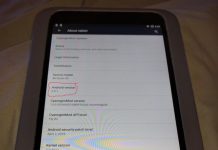The latest figures on Android OS version usage and Android device screen size from the Google Developer Dashboards, “collected during a 7-day period ending on January 8, 2014,” show that the oft-cited myth of Android platform fragmentation, often used as a pretext for preferring iOS, is ever more a thing of the past. And given the very well-informed complaints around the latest version of iOS, and features on the various sizes of iPad, and problems with Apple TV and other gadgets, it’s also a myth that Apple devices don’t suffer from fragmentation. (Warner Crocker: “I don’t buy the apologists who say that iOS 7 was such a massive rebuild that we should forgive and wait for updates. In fact, I find that insulting, and think anyone who paid the prices Apple charges for its devices should be insulted as well.”) So now read on.
Android users with any medium-term experience won’t need to be told that there’s a great divide between the Android 2.x iterations and the subsequent versions. And the good news is that Gingerbread, the most common and most “advanced” of the 2.x versions, is now down to just 21.2 percent of the Android user base registered by the Dashboards. Subsequent versions and sub-versions are well up in the 75 percent range. If there is any bad news, it’s that the absolute latest version, KitKat, is still at only 1.4 percent, which suggests both that the very latest devices are not burning up the market yet, and that phone manufacturers are still being slow at rolling out updates to their customers.
Also, screen size remains overwhelmingly (78 percent) tilted towards “normal” size devices – in the 4-inch range for phones. This may raise some concerns about Android’s readiness to break out separate development channels and opportunities for tablets, but it does make life easier for developers.
So if you’re a developer looking to program for Android, you have a 75-percent chance of getting it right if you focus on the various versions of Android 4.x, which are far closer in format and features than previous versions. And why would you want to develop for the trailing-edge OS variant that is falling out of use anyway? That pushes your target OS variant range up closer to 100 percent. Hardly sounds like fragmentation to me.

































Another thought. At least among new devices, the only ones that really run a 2.x version of Android tend to be the cheapest of cheap devices; essentially existing in the niche where feature phones existed over the last couple of years. I suspect that KitKat, which is designed to use lower power hardware, will soon start penetrating that space.